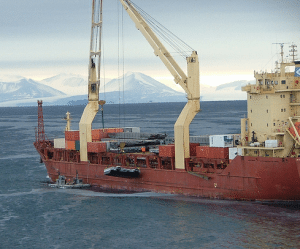Trump Tariffs on Russia’s Oil Buyers Bring Economic, Political Risks
From punishing Brazil to trying to curb imports of fentanyl, U.S. President Donald Trump has wielded the threat of tariffs as an all-purpose foreign policy weapon.


With the summer season officially over in Antarctica, International scientists in the region are finishing construction projects and are buttoning up McMurdo station in preparation for the coming winter. One impressive project that’s been recently completed for U.S. Transportation Command is the replacement of an ice pier that was unusable due to uncharacteristically high temperatures this year at the world’s southernmost harbor, McMurdo Sound, Antarctica.
The new pier was built to enable the National Science Foundation staff to resupply workers at McMurdo Station, the largest community on the frozen continent.
Normally, the resupply ship docks at an ice pier built out into the sound. The ice bridge usually can take the weight of trucks, containers, heavy equipment and supplies. But this year, that wasn’t the case.
“We were notified in November that the ice pier that is used to accept cargo at McMurdo was unusable this year,” said Col. Howard McArthur, the West Branch chief at TRANSCOM.
To accept the heavy use, the ice pier has to be about 20 feet thick. This year, it was only 9 feet. The NSF, which runs the Antarctic research effort, had a problem.
Whatever they were going to do had to happen quickly. About 150 people spend the winter at McMurdo Station, and there is only one annual supply ship for the entire year. It arrives just before winter sets in, and carries food, scientific instruments, general supplies and everything else needed to run the station and supply other research stations. Another ship brings in about 6 million gallons of fuel.
“Through collaboration between TRANSCOM, Pacific Command’s Joint Task Force Support Forces to Antarctica and the National Science Foundation, it was determined that the Army’s modular causeway system would work,” said Army Lt. Col. Rich Whittingslow, the Pacific Command branch chief at TRANSCOM.
In early December, Army Capt. Christina Shelton, the commander of the 331st Transportation Company based at Joint Base Langley-Eustis, Va., got a phone call telling her to prepare her unit for movement to Antarctica.
“I thought they were joking,” she said.
The mission was to transport the system to Port Hueneme, Calif., load it aboard the Green Wave and send it to Antarctica. Soldiers then would fly to McMurdo to be in place when the ship arrived, and build the pier so that the supplies aboard the Green Wave could be off-loaded.
Once that was done, they would have to disassemble the pier, load it back on the ship and go home. Nothing like it had been done before.
“We were very excited, because we train year-round for any type of global contingency operations, whether it is warfighting, humanitarian operations and anything of that nature,” Shelton said.
It usually is just training, and this “was a real-world mission,” she said. “It was a chance to put our expertise to work.”
Soldiers loaded the gear onto 52 commercial trucks for the trip to Port Hueneme. They loaded aboard the Green Wave and the ship set sail Jan. 16.
Shelton said she knew there would be challenges, not the least of which was temperature. When the Soldiers arrived Feb. 10, the temperature was a relatively balmy 28 degrees.
“It quickly got colder and much windier,” the captain said.
Temperatures dropped well below zero, and with the wind chill it was like working in 60-below-zero temperatures, she said.
The NSF staff issued the full set of gear to work in these conditions to the Soldiers.
“We had cold-weather parkas, bunny boots, extreme cold-weather gloves, balaclavas, special wool socks – everything we needed to build the pier,” Shelton said.
The Green Wave arrived at McMurdo Station on Feb. 13. Joining the Soldiers were 50 Sailors from the Navy Cargo Handling Battalion in Norfolk, Va.
The first two items off the Green Wave were two working tugs, used to push and pull the pieces of the causeway in place. Next, they built the floating portions of the causeway aboard the ship, and lowered them into the water where they fastened them together. These so-called “strings” were 80 feet long by 8 feet wide.
The whole process took two and a half days.
“We would have been done sooner, but it was the first time we had built these aboard ship and the first time we worked with Sailors manning the on-board cranes,” Shelton said. “We got better as we went along.”
It took eight days of 24-hour operations to unload the ship.
Finally, the Soldiers took 36 hours to take the pier apart and reload it aboard the Green Wave. The 331st Transportation Command Soldiers were on the ground in Antarctica from Feb. 10-29. They flew to Christchurch, New Zealand, from Antarctica, and arrived back in Virginia in March.
Officials from the NSF staff are working on a plan to rebuild the ice pier for next year, but it may not be ready. If that’s the case, they may need the steel pier again.
“With what we know now, we can do it even better next year,” Shelton said.

Sign up for gCaptain’s newsletter and never miss an update

Subscribe to gCaptain Daily and stay informed with the latest global maritime and offshore news


Stay informed with the latest maritime and offshore news, delivered daily straight to your inbox
Essential news coupled with the finest maritime content sourced from across the globe.
Sign Up